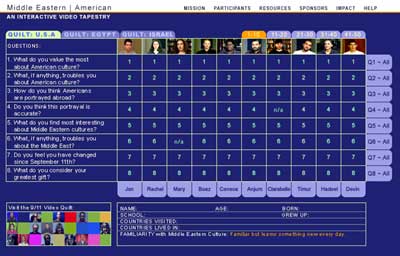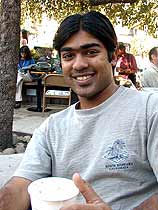|

|

|
NEWS
SEARCH
|
|
|
|

|
 |
| In
"Middle Eastern | American: An Interactive Video Tapestry,"
42 students from the Bay Area and New York talk about how
they view both cultures. The site's visitors can choose
several ways to listen to the hundreds of segments. |
Generation
Y wrestles with 9/11 in new Web video project
18 September 2002
By Bonnie Azab Powell, Public Affairs
BERKELEY - After the attacks of September 11, Americans
of all ages struggled to understand how the world perceives
us, agonizing over our place in the world. With "Middle Eastern
| American: An Interactive Video Tapestry," UC Berkeley alumna
Ana Pinto da Silva (Architecture, 1991) takes this process public.
Funded by an outreach grant from the university's Center for
Middle Eastern Studies, Pinto da Silva interviewed and filmed
42 New York and Bay Area students, including four from UC Berkeley.
Aged 16 to 24, the interviewees possess wildly diverse backgrounds,
religions, and ethnicities. They share their opinions of the
best and worst of American and Middle Eastern cultures in a
tapestry of video segments that the viewer can watch in a number
of interactive ways. The students also tell how 9/11 changed
their lives — or how it did not — and what each believes
his or her greatest personal gift to be.
 |
 |
| Berkeley
Ph.D. student Keshav Dani agreed to be interviewed for the
video tapestry after da Silva approached him on the street.
"Of course I will help out another researcher,"
Dani explains. Photo by BAP |
As a recent letter to the online publication Salon points out,
the media too often talk about youth and too rarely to
youth. This site takes that notion one better: here, you listen.
And in contrast to the callow, consumerist stereotype that
frequently dogs Generation Y, what we hear from these students
are thoughtful, articulate expressions of the need for peace
and understanding between cultures. This comes as no surprise
to Pinto da Silva, who spends a lot of time with young adults.
In addition to heading Workshop 173, a Bay Area design firm,
she teaches at San Francisco State University's multimedia studies
program and volunteers with Art and Film for Teenagers, a community
outreach program.
"I think a lot of people are afraid of teenagers because of
their prickly exteriors, but it's so important to engage with
them, " Pinto da Silva says. "They're very forthright. As we
get older, we become more circumspect about our opinions. Teenagers
call adults on our functional hypocrisy."
The participants in the project certainly don't pull their
punches. They agree on what they value most about American culture
— freedom and diversity. And they are also united in what
troubles them about their home country: the U.S. is materialistic,
shallow, hypocritical and racist, alleges voice after voice.
Abroad, the U.S. is perceived as ignorant, haughty and rich,
say the students, many of whom were born or have traveled extensively
outside the States. They are divided on whether that perception
is accurate.
The most interesting — and revealing — answers are
given in response to the question, "Do you feel you have changed
since 9/11?" Nearly every U.S.-born student says yes, and details
feelings of shock, a greater interest in world news, dissatisfaction
with the government, and an increased sense of life's fragility.
Meanwhile, most of the foreign-born students say they were
less shaken by the events of 9/11. Berkeley physics PhD student
Keshav Dani, 23, who is from India, puts it this way: "I don't
think it has changed me. Terrorism was something that has been
going on in India, in Kashmir or other parts of the world, and
I'd been following it ... It came to America, but I haven't
been in America all my life."
He himself may not have been changed by 9/11, but Dani does
believe that America has, he said in a recent interview after
the anniversary of the attacks. "There's a sense of vulnerability
and insecurity now that I don't think was present before. People
are asking themselves a lot of questions that I think they should
be."
Many of the students tell how their lives have been affected
by the changes in America. A dark-skinned, bearded student stoically
describes being called "Osama bin Laden" and the pain of having
his classmates stop talking to him. A Saudi Arabian woman recounts
attempting to explain to friends how she could be Muslim and
yet not sympathize with the terrorists.
 |
 |
 |
| Friends
Jon (top), an Afghan Muslim, and Jonathan (bottom), an Iranian
Jew, traveled to New York City from Boston to record their
views. |
For best friends Jon and Jonathan (on the Web site, Pinto da
Silva uses only first names to protect students' privacy), the
9/11 attacks gave their friendship a special significance. Jon
is an Afghani Muslim, while Jonathan comes from an Iranian Jewish
family. They heard through a friend of a friend of a friend
about Pinto da Silva's search for interview subjects, and took
the train to New York from Boston to participate.
"For most people I'll be the only Afghan they ever meet," Jon
says in the taped segment describing his greatest personal gift
— his understanding of both American and Middle Eastern
ways of thinking. "I have to make the best impression possible.
I try to make people understand that in our country, we are
not just Taliban or starving refugees in Pakistan. That we have
a rich culture and we are able to have fun and be good neighbors."
This multiplicity of reactions and viewpoints are what make
"Middle Eastern | American: An Interactive Video Tapestry"
so valuable. Although Pinto da Silva intended the site to be
used as a classroom tool with which teachers can spark discussion,
she also hopes the project will someday aid international diplomacy.
To that end, she would like to translate the current segments
into Arabic, so they can be viewed by the Middle Eastern world,
and to travel to Egypt and/or Israel to undertake complementary
interviews with youth there. But first she must get additional
funding, and surmount formidable cultural and language barriers.
The $12,800 outreach grant from the Center for Middle Eastern
Studies' Al-Falah Program barely covered the expenses of the
project, like hiring a camera operator and sound engineer. Pinto
da Silva built the entire Web site herself, sifting through
hours of footage and teaching herself how to use video streaming
and editing software.
"The pilot project has great potential," says Nezar AlSayyad,
director of the Center for Middle Eastern Studies and Pinto
da Silva's collaborator for the project. "I would like to see
Ana make it into something that can be shown perhaps on public
television. I think the principal value is not as a teaching
tool, but as an instrument for understanding in the world outside
the university."
Few people with hard-and-fast views, whether Middle Eastern
or American, will have their minds changed by the project, AlSayyad
acknowledges. However, "it shows how complex Americans are and
how powerful personal experience can be in shaping culture and
attitudes," he continues. "It also provides a way
for people to learn about Muslims even by default — that
while some are very different, others cannot be distinguished
from other Americans by looks, accents or anything else."
For Pinto da Silva, the project has achieved her primary goal,
even without the Egypt/Israel segments. "Instead of the world
getting its impressions of young Americans just from Britney
Spears," she says, "I think it's far better for them to listen
to real people like Jon and Keshav and see what thoughtful human
beings they are."
Visit the
"Middle Eastern | American: An Interactive Video Tapestry" project
|

|